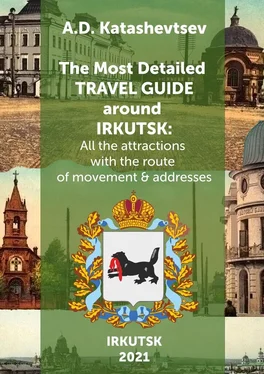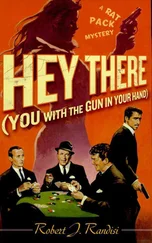1 ...7 8 9 11 12 13 ...16 Earlier, starting from the 1780s, this place was occupied by Ivanovskaya Square with trading rows of Melochny (“Trivial”) Bazaar, where people traded mainly in agricultural goods brought from the villages. Behind the circus building, you can still see the shops of the Old City Public Administration, which have been occupied by a mica factory since 1929 (now Sverdlova Str., 41).
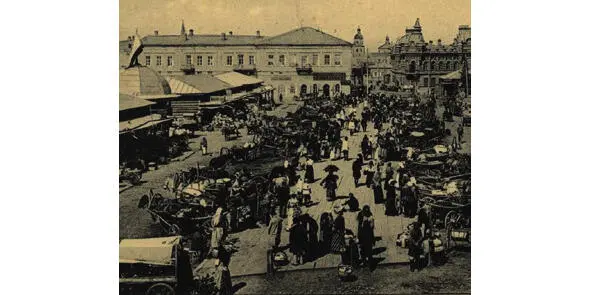
Trading rows of Melochny (“Trivial”) Bazaar
Here from the house of the merchant V.A. Ostapin on June 22, 1879, the Great Fire began, which destroyed the best part of Irkutsk. The flames blazed for three days and swallowed up the entire city center. Burnt out 75 blocks with 105 stone and 3418 wooden buildings. The fire took away practically all public, educational and state institutions, many temples, museum; also destroyed the entire city archive with unique documents.
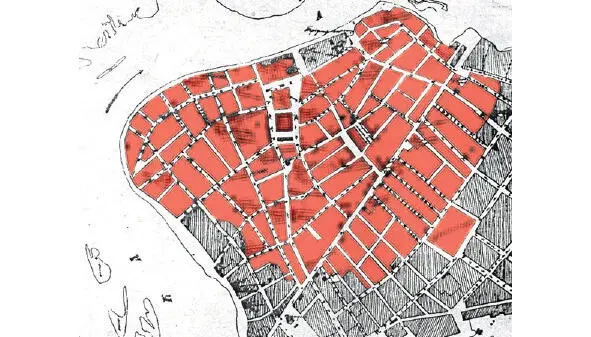
Map of the Great Fire in Irkutsk
However, one of the oldest buildings in Irkutsk is still preserved on the other side of the square – the building of the hotel “Moscow Courtyard” created in 1821 at the expense of the merchant N.P. Trapeznikov, and donated to the city for free use of the City Court in 1887 by his grand-nephew, which already known to us as V.P. Sukachev. The justice authorities are here to this day.

Moscow Courtyard
At the end of the ensemble of the square, the building of the central telegraph, built in 1932 by the architect N.N. Baikov. It is located on the site of the former house of I. A. Nemchinov, where in November 1903 the main telegraph office of Irkutsk was transferred. Today the representative office of OJSC “Rostelecom” is located here.
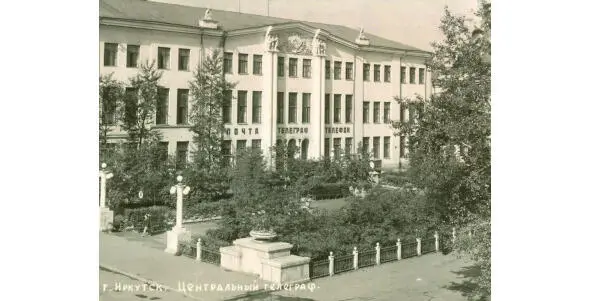
Main telegraph office of Irkutsk
There is an illuminated fountain in the center of the square. Earlier in its place was located one of the most picturesque stone chapels of Irkutsk – in the name of the Iveron Icon of the Mother of God. It was installed here in 1892 by the architect V.A. Kudelsky at the expense of the Irkutsk industrialist and philanthropist A.M. Sibiryakov.
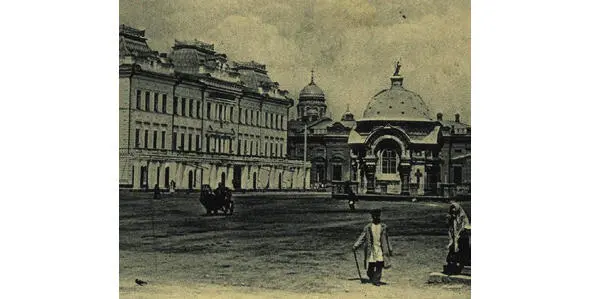
Chapel in the name of the Iveron Icon of the Mother of God
Noteworthy is the nearby best monument in Russia to the famous film director L.I. Gaidai, established here in 2012. For a talented cinematographer, Irkutsk has become a fateful city. Here he graduated from school No. 42 (now Lyceum No. 36 of JSC “Russian Railways”), volunteered for the front, returned injured, received his first theatrical experience and decided to become an actor. In addition, L.I. Gaidai wrote his first script, which brought him worldwide fame for the film “Dog Barbos and Unusual Cross”, when had found a play of S.I. Oleinik in the attic of his parents’ house in Irkutsk in 1961. It is the scene from this film that is shown in the composition of the monument designed by S.B. Demkov.
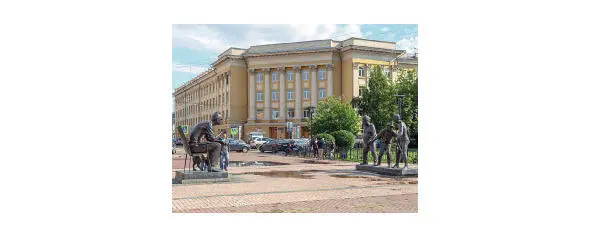
Monument to the famous film director L.I. Gaidai
Well, and we continue to move along Sverdlov Street, in the past it bore the name of an outstanding merchant, philanthropist and mayor V.N. Basnin. Today only the library wing, where the “Museum of Communications” is located, and also a small house facing the main street, remained from his family estate. The latter is one of the oldest stone residential buildings in the city and was built in 1801, but lost its second floor after the Great Fire.

V.N. Basnin’s estate
Since 1834, almost a third of this quarter was occupied by the Basnin’s Garden with greenhouses, the collection of which was formed by the best expert of Asian plants among his contemporaries N.S. Turchaninov. However, the fire element did not spare it either. Today in its place is the school No. 11, built in 1915 according to the project of K.W. Mital. The graduates of this institution were the Hero of the Soviet Union A.S. Bogdanov, cosmonaut A.A. Ivanishin, pianist D.L. Matsuev and many other famous scientists and public figures.
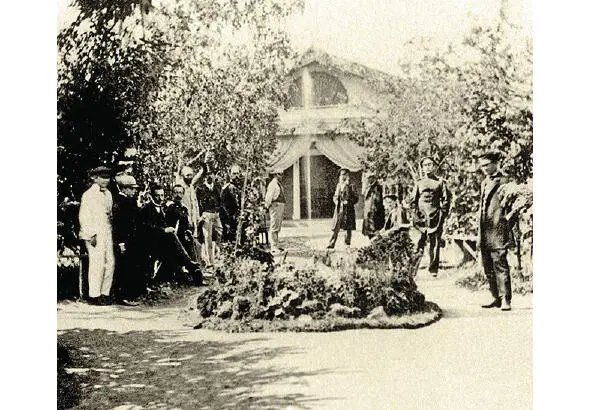
Basnin’s Garden
Right behind the school is the building of the former hotel “Commercial Courtyard”, which opened here in 1902. After the revolution and up to the 1970s, it housed a dormitory for Irkutsk theatre workers, and during the WWII the actors of Moscow Satire Theater and Kiev Opera Theater lived here. Today it occupied by various departments and committees of the Irkutsk administration.

Hotel “Commercial Courtyard”
Opposite there is a one-storey house where lived the famous explorer of the Eastern Sayan Mountains and the merchant S.P. Peretolchin. Immediately behind it is the small building of the poorhouse of the Tikhvin Church, adjoining against the walls of the “Vostsibugol” building – the only construction that has survived from that magnificent temple.
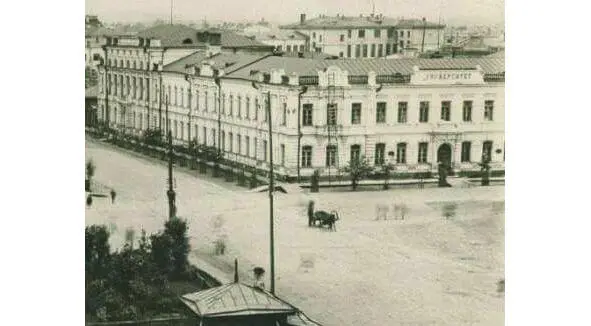
2nd Khaminov’s gymnasium for girls
On the opposite side of the road, the department of humanitarian and aesthetic education of the Pedagogical Institute of Irkutsk State University, which is located in the building of the former 2nd Khaminov’s gymnasium for girls, which opened here in 1912. Here at the school of red commanders for four months in 1920 studied the future founder of Mongolia D. Sukhe-Bator, after whom named this street. In 1935, according to the project of K.W. Mital, a “party activist house” was added to the gymnasium building, which today also occupied by ISU.
We turn right to the main merchant street of Irkutsk, named today in honour of A.I. Zhelyabov who was one of the organizers of the assassination of Emperor Alexander II. In the past, it bore the name of famous merchant of the 1st guild, twice elected mayor and patron of the arts K.N. Trapeznikov. There are many beautiful merchant mansions along the street.
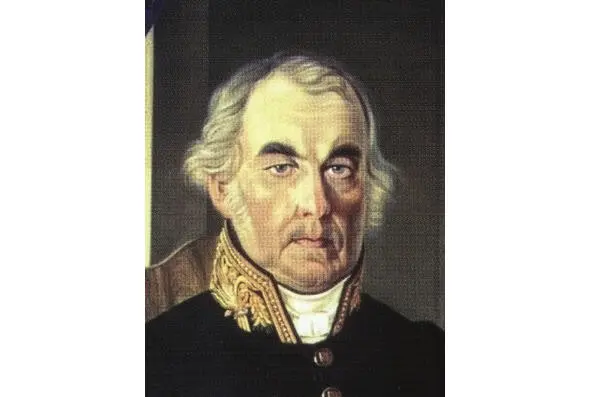
Merchant of the 1st guild K.N. Trapeznikov
Читать дальше
